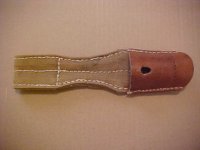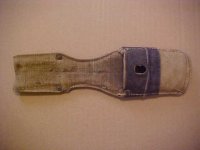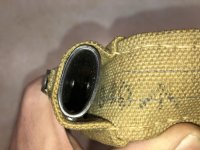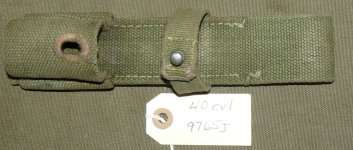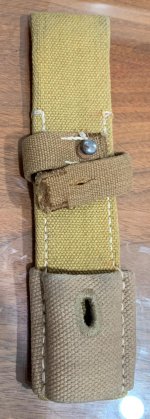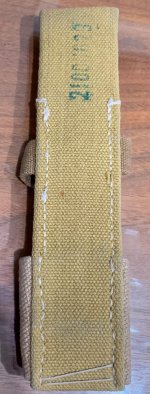As an alternative to leather and initially for use in the tropical climate of the Mediterranean, the Germans produced a new pattern of frog made of heavy cotton webbing. These frogs are found in primary colors of olive drab, reed green, a yellow ocher, tan, and indigo blue. However, some are found to have up to three colors of webbing used in their construction...one each for the frog body, pouch, and retention strap. Frogs with off-shades of tan or gray webbing are also found. In addition, the webbing is usually of two types. Frogs #1A, #1B & similar examples have the most common, more coarse type webbing. Frog #1C and the three "Multi, off-color" variants exhibit a finer, tighter weave. This is likely due to different mills which supplied the material to specific manufacturers.
There are also some variants of the M42 web & leather frog with the frog body being composed of yellowish or gray webbing, but those are another pattern altogether. A somewhat larger pattern may exist for the S98/05. This might be the result of a slightly larger than average frog having been stretched out from use with this bayonet. However, a larger web variant does exist for the Luftwaffe survival knife/machete.
The color of stitching is usually white, but black was also used. In addition, various colors of thread were utilized for reinforcement around the pouch frog stud hole, around the stud hole in one retention strap and ends of both retention straps as well. Typically there will be a small piece of leather (or later webbing), stitched to the underside of the retention strap where the stud is located...thus protecting the bayonet grip from the peened metal base of the stud. The majority of frogs encountered tend not to have any manufacturer's ink markings applied to the obverse side. Wear and exposure often obliterate such markings or render them illegible.
Frogs from top to bottom, left to right are:
1st row:
1A. Olive Drab. Obverse clearly marked in purple ink OFFERMAN|BENSBURG|1942.
1B. Reed green/no markings.
1C. Yellow Oche. Obverse in large black ink markings "892".
1D. Indigo Blue for issue to Luftwaffe.
1E. Multi, off-color pattern with yellowish frog body & variant tan pouch.
2nd row:
2A. Reed green dual-tone with tan pouch & retention strap.
2B. Tan dual-tone with reed-green retention strap.
2C. Multi, off-color pattern.
2D. "Sandy" pattern with bright yellow body, tan pouch, & bronze retention strap. Illegible contract number in green ink on obverse. I was told most of these came out of a storage facility in France sometime in the late 1970s/early 1980s, in un-issued condition.
2E. This last one is similar to the combination of webbing used in the "Sandy" variant. However, construction is different and black stitching was used.
3rd row:
3A. Unusual, uncommon variation. Constructed of very heavy webbing. Frog is actually two layers of webbing sewn together and bent over to form frog body. The initial stitching is black, with the final assembly stitch being white. Pouch & retention straps are also reinforced.
3B. A third multi, off-color variant slightly different from the other two.
There are also some variants of the M42 web & leather frog with the frog body being composed of yellowish or gray webbing, but those are another pattern altogether. A somewhat larger pattern may exist for the S98/05. This might be the result of a slightly larger than average frog having been stretched out from use with this bayonet. However, a larger web variant does exist for the Luftwaffe survival knife/machete.
The color of stitching is usually white, but black was also used. In addition, various colors of thread were utilized for reinforcement around the pouch frog stud hole, around the stud hole in one retention strap and ends of both retention straps as well. Typically there will be a small piece of leather (or later webbing), stitched to the underside of the retention strap where the stud is located...thus protecting the bayonet grip from the peened metal base of the stud. The majority of frogs encountered tend not to have any manufacturer's ink markings applied to the obverse side. Wear and exposure often obliterate such markings or render them illegible.
Frogs from top to bottom, left to right are:
1st row:
1A. Olive Drab. Obverse clearly marked in purple ink OFFERMAN|BENSBURG|1942.
1B. Reed green/no markings.
1C. Yellow Oche. Obverse in large black ink markings "892".
1D. Indigo Blue for issue to Luftwaffe.
1E. Multi, off-color pattern with yellowish frog body & variant tan pouch.
2nd row:
2A. Reed green dual-tone with tan pouch & retention strap.
2B. Tan dual-tone with reed-green retention strap.
2C. Multi, off-color pattern.
2D. "Sandy" pattern with bright yellow body, tan pouch, & bronze retention strap. Illegible contract number in green ink on obverse. I was told most of these came out of a storage facility in France sometime in the late 1970s/early 1980s, in un-issued condition.
2E. This last one is similar to the combination of webbing used in the "Sandy" variant. However, construction is different and black stitching was used.
3rd row:
3A. Unusual, uncommon variation. Constructed of very heavy webbing. Frog is actually two layers of webbing sewn together and bent over to form frog body. The initial stitching is black, with the final assembly stitch being white. Pouch & retention straps are also reinforced.
3B. A third multi, off-color variant slightly different from the other two.
Attachments
-
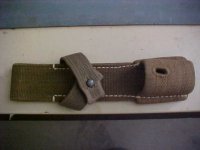 tf9.JPG21.1 KB · Views: 103
tf9.JPG21.1 KB · Views: 103 -
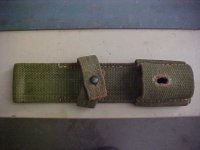 tf10.JPG23.3 KB · Views: 119
tf10.JPG23.3 KB · Views: 119 -
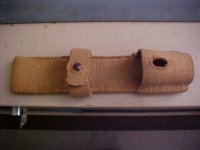 tf2.JPG20.5 KB · Views: 115
tf2.JPG20.5 KB · Views: 115 -
 tf11.JPG21 KB · Views: 107
tf11.JPG21 KB · Views: 107 -
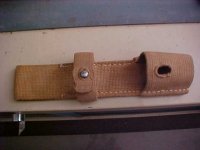 tf1.JPG21.8 KB · Views: 105
tf1.JPG21.8 KB · Views: 105 -
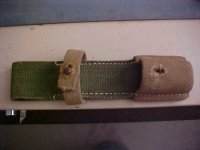 tf3.JPG22.6 KB · Views: 96
tf3.JPG22.6 KB · Views: 96 -
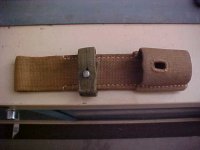 tf4.JPG22.4 KB · Views: 94
tf4.JPG22.4 KB · Views: 94 -
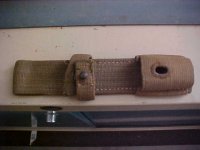 tf5.JPG21.7 KB · Views: 95
tf5.JPG21.7 KB · Views: 95 -
 tf12.JPG22.6 KB · Views: 102
tf12.JPG22.6 KB · Views: 102 -
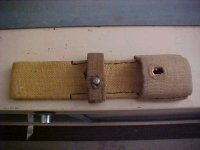 tf6.JPG23.4 KB · Views: 101
tf6.JPG23.4 KB · Views: 101 -
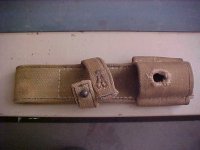 tf7.JPG23.3 KB · Views: 109
tf7.JPG23.3 KB · Views: 109 -
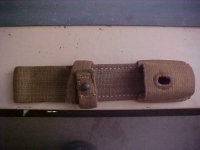 tf8.JPG20.8 KB · Views: 109
tf8.JPG20.8 KB · Views: 109
Last edited:




